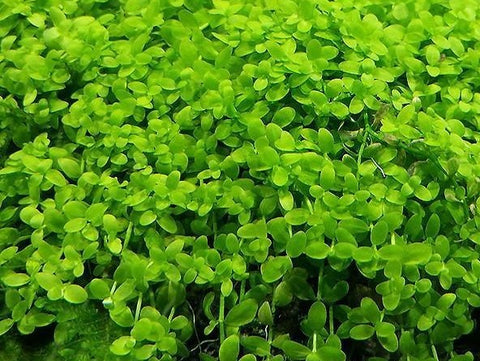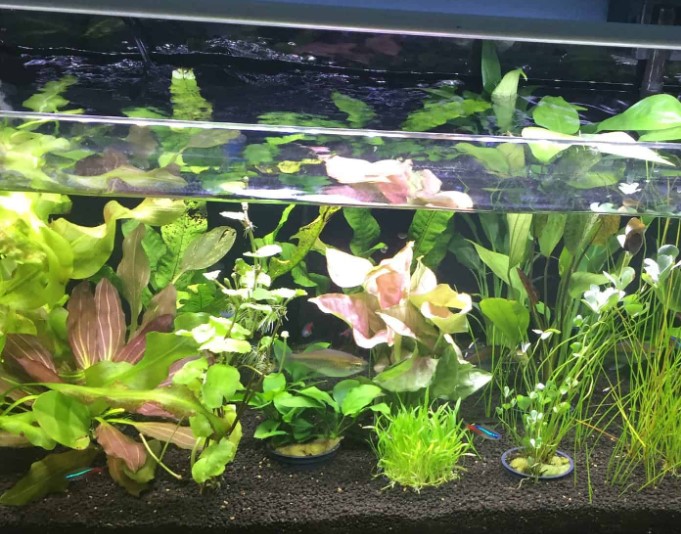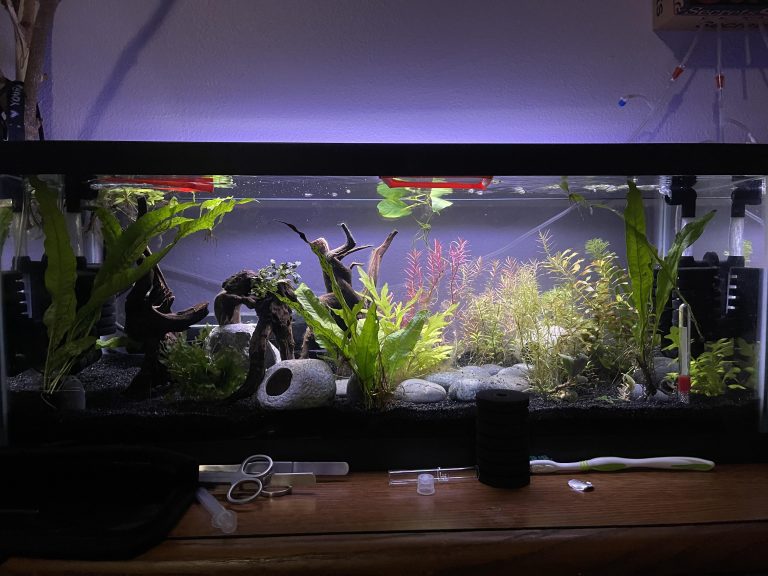How to Safely Quarantine Aquarium Plants: A Step-by-Step Guide
To quarantine aquarium plants, separate them from other fish and equipment for two to three weeks. This ensures that any potential pests or diseases do not spread to the rest of the aquarium.
Aquarium plants serve as important visual components of any aquarium. Besides adding aesthetic value, they help reduce algae growth and provide hiding places for fish. However, introducing new plants to your established aquarium may risk introducing pests and diseases that could harm the fish and other aquatic plants.
Therefore, it is crucial to quarantine new plants before introducing them to a community tank. This precautionary measure involves separating the plants from other equipment and fish for at least two weeks. This article outlines the essential steps that will keep your aquarium plants disease and pest-free.

Credit: buceplant.com
Understanding The Importance Of Quarantining Aquarium Plants
Maintaining a healthy aquarium environment is essential, and one of the best ways to ensure this is by quarantining new plants before introducing them to the main tank. Quarantine refers to the process of isolating new aquarium plants in a separate tank for a specific period before introducing them into the main aquarium.
The quarantine process is an important step, and here’s why:
Why Quarantining Aquarium Plants Is Important
Quarantining aquarium plants can help prevent the spread of diseases and parasites, ensure the plants’ compatibility with other species in the tank, and help stabilize the new plants before you introduce them into the main aquarium.
Here are some reasons why you should consider quarantining aquarium plants:
- Prevents the spread of illnesses: Quarantining new aquarium plants helps to prevent new diseases or parasites from spreading to the other plants and organisms in the aquarium. This way, you can prevent potential health problems that could affect the aquatic life in your aquarium.
- Ensures compatibility with other species: Quarantine gives you an opportunity to understand the new plant’s behavior and ensure it is compatible with others in the main tank. This way, you can prevent conflicts and ensure a peaceful environment.
- Stabilizes new plants: The period between buying new plants and introducing them into the main tank can be stressful for the plant. Quarantine helps to stabilize new plants by reducing stress and allowing them to acclimate to the new environment.
How It Helps Prevent The Spread Of Diseases And Parasites
Diseases and parasites can quickly spread in an aquarium, leading to the illness and even death of your aquatic life. Quarantining aquarium plants can help to minimize the risk of disease and parasite outbreaks.
Here’s how the process works:
- Isolation period: The primary aim of the quarantine period is to ensure that there are no diseases or parasites present on the new plant. During this period, observe the plant for signs of disease or parasites and take corrective action as appropriate.
- Treatment: If you observe any signs of diseases or parasites, it is essential to treat the plant before introducing it into the main aquarium. This way, you can keep the other organisms in your aquarium safe.
- Monitoring: After treatment, continue to monitor the plant for several days to ensure that it is healthy before introducing it into the main tank.
What You Need To Know Before Starting The Quarantine Process
Before you start the quarantine process, here are some essential things you need to know:
- Invest in a separate tank: You will need a separate tank, filter, and heater for the quarantine process. Ensure that the separate tank’s equipment is working correctly before starting the process.
- Quarantine period: The quarantine period should be at least two weeks to allow enough time for observation and treatment if necessary.
- Observe the plant: During quarantine, observe the plant closely for any signs of disease or parasites, such as brown spots, holes, or unusual growths.
- Conditions of the quarantine tank: Ensure that the plants’ quarantine tank’s water conditions are similar to those in your main aquarium to minimize stress on the plant.
Quarantine is an essential process for all aquarium enthusiasts. By understanding the importance of quarantine and how it can benefit your aquarium’s health, you can be sure that your aquatic life is safe and healthy.
Preparing For Quarantine
Aquarium plants are vital for creating a natural and healthy environment for your aquatic pets. However, they can also introduce disease and harmful parasites to your aquarium if they are not appropriately quarantined. We will guide you through the process of preparing for quarantine of aquarium plants.
Choosing The Right Quarantine Tank
Choosing an appropriate quarantine tank is essential to maintain a healthy and disease-free environment. Here are a few things to keep in mind when selecting a quarantine tank:
- The size of the quarantine tank should be sufficient to accommodate the plants you want to quarantine.
- The tank should be equipped with a heater, filter, and an airstone to maintain water quality and oxygen level.
- Use a clear and transparent tank to allow unobstructed observation of the plants during acclimation.
Sterilizing And Disinfecting The Quarantine Tank And Equipment
Before introducing the plants to the quarantine tank, it is crucial to sterilize and disinfect every equipment that comes in contact with the plants. Here’s how you can do it:
- Soak the tank, heater, filter, and ornaments in a bleach solution (1 part bleach to 10 parts water) for 24 hours.
- Rinse and soak them in fresh dechlorinated water for another 24 hours.
- Use a separate set of tools and equipment dedicated to the quarantine tank.
Acclimating Your Plants To The Quarantine Tank
Acclimation of the plants is a crucial step in the quarantine process. Here’s how you can do it:
- Carefully remove the plants from the main aquarium and rinse them thoroughly in fresh dechlorinated water.
- Place the plants in the quarantine tank and cover the top with a mesh to prevent them from jumping out.
- Allow the plants to acclimate for at least 14 days, monitoring them closely for any signs of stress or disease.
Monitoring Your Plants For Signs Of Stress Or Disease During Acclimation
During acclimation, it is essential to observe the plants closely for any signs of disease or stress. Here are a few symptoms to keep an eye on:
- Discoloration of leaves or stems
- Leaves that start to wither or deteriorate
- Presence of white spots or patches on the leaves
- New growth that appears limp or discolored
- Leaves that appear slimy or have a foul odor
By following these guidelines, you can ensure that your aquarium plants are appropriately quarantined and free from any diseases or parasites that may harm your aquatic pets.
Transferring The Plants To The Quarantine Tank
How To Properly Remove The Plants From Their Original Tank
When it comes to transferring your aquarium plants to a quarantine tank, it’s important to take some steps to ensure your plants thrive in their new environment. Here are some key points to follow when removing the plants from their original tank:
- Turn off any equipment that may cause disturbance while removing the plants.
- Carefully remove the plants from the substrate without damaging their root system.
- Inspect the plants thoroughly to ensure they are healthy and pest-free.
- Rinse the plants under running water to remove any debris or unwanted organisms on the leaves and roots.
Preparing The Quarantine Tank For The New Plants
When setting up a quarantine tank for your aquarium plants, it’s important to create a suitable environment free from any potential disease carriers. Here are some steps to follow when preparing the quarantine tank:
- Choose a suitable tank size, at least one-third of your original tank size.
- Add an appropriate substrate and set up a filtration system.
- Add a heater and ensure the water temperature is around 75-80°f.
- Install a water testing kit to monitor the water quality.
- Do not add any fish or invertebrates to the quarantine tank.
Adding The Plants To The Quarantine Tank
Once you have prepared your quarantine tank, it’s time to add the plants. Here are key points to keep in mind:
- Gently place the plants in the quarantine tank.
- Avoid overcrowding the tank.
- Keep the lights off for the first 24 hours to prevent any possible algae growth.
- Gradually acclimate the plants to their new environment by keeping an eye on their growth over the next few days.
Checking The Water Conditions Regularly During The Quarantine Period
During the quarantine period, it’s important to monitor the water conditions to ensure the plant’s health. Here are some key points to adhere to:
- Test the water every few days to monitor ph, ammonia, nitrate, and nitrite levels.
- Maintain water quality by performing water changes every other week.
- Observe the plants for any signs of wilting or pest infestations.
- Check for any anomalies in the quarantine tank’s equipment, including the heater and filter.
- Avoid using any medication or treatments unless it’s necessary.
By following these steps to quarantine your aquarium plants, you can help ensure that they remain healthy and don’t carry any potential diseases or pests into your main aquarium. Happy gardening!
Maintaining The Quarantine Tank
Quarantining aquarium plants is a vital process that every aquarist should carry out when introducing new plants to their tanks. A quarantine tank is a separate space where newly purchased aquarium plants can be monitored for several weeks to ensure they are disease and parasite-free before they are added to the main tank.
In this section, we will take a closer look at how to maintain the quarantine tank properly.
Regular Water Changes And Cleaning Of The Tank
Maintaining a clean and healthy environment in the quarantine tank requires regular water changes. The recommended schedule is weekly water changes of 25% of the tank’s water volume. When doing a water change, it’s essential also to clean the tank’s surfaces and the plants using a soft-bristled brush.
Here are the key points to keep in mind:
- Perform weekly water changes of 25% of the tank’s water volume.
- Clean the tank surfaces and plants using a soft-bristled brush during water changes.
How To Properly Feed The Plants During Quarantine
Plants need nutrition to thrive, even during quarantine. Feeding the plants in the quarantine tank is crucial to ensure they remain healthy and recover from any stress due to handling during the purchase. The type of food and feeding frequency depend on the type of plants.
Root feeders require different food than stem feeders, so it is necessary to research the plants you have and their feeding preference. Here are the key points to keep in mind:
- Research the type of plants to know their feeding needs.
- Feed the plants in the quarantine tank based on their feeding preference.
Inspecting The Plants For Signs Of Diseases Or Parasites
Inspection of the plants during quarantine is essential to detect any signs of diseases or parasites. Regular observation and inspection of the plants’ leaves, stems, and roots can help you detect symptoms of any health condition early before it spreads and affects other plants in the main tank.
Here are the key points to keep in mind:
- Inspect the plants thoroughly before adding them to the main aquarium.
- Observe the plants for any signs of diseases or parasites.
Adding Any Necessary Treatments To The Water
If any plants show signs of illness during the quarantine period, it is crucial to treat them immediately to prevent it from spreading to other plants in the quarantine tank or main tank. Water treatments such as broad-spectrum antifungal or antibacterial medications can help alleviate the disease’s symptoms in the plants.
Here are the key points to keep in mind:
- Treat any plants that show signs of illness as soon as possible.
- Use broad-spectrum antifungal or antibacterial medications to treat the disease’s symptoms.
By following these tips, you can maintain a clean and healthy quarantine tank for your aquarium plants. Remember that the goal of the quarantine tank is to ensure that any newly purchased plants are healthy and disease-free before introducing them to the main aquarium.
Frequently Asked Questions Of How To Quarantine Aquarium Plants
How To Quarantine Aquarium Plants?
Quarantining aquarium plants involves examining, treating and isolating new plants to ensure they are free of disease and pests before adding them to an established aquarium setup.
Why Is It Necessary To Quarantine Aquarium Plants?
Quarantine tanks ensure that any disease or pests that may be carried on the new plants will not affect the established aquarium setup, minimizing the risk of harm to your fish.
How Long To Quarantine Aquarium Plants?
It’s recommended to quarantine new aquarium plants for at least two weeks to observe them for any signs of disease, pests or to observe if they acclimate well.
Can You Prevent The Need For Quarantine?
Prevention involves careful observation of your aquarium plants for any signs of pest or disease, choosing reputable suppliers, and periodic inspections of new plants before adding them.
Conclusion
Maintaining a healthy aquarium can be a challenging task, but it becomes even more important when you introduce new plants or fish into your aquarium. Quarantining your aquarium plants is a proactive measure that you can take to prevent the spread of any diseases or pests that may be present in new plants.
Following the above guidelines will allow you to safely and effectively quarantine your aquarium plants, providing a clean and healthy environment for your aquatic life. Remember to keep your plants isolated for a minimum of two weeks, to use a good sterilization solution, to inspect your plants regularly, and to ask for help and advice from other experienced aquarium enthusiasts.
By taking these steps, you are ensuring that your aquarium stays healthy, vibrant, and beautiful for years to come.





